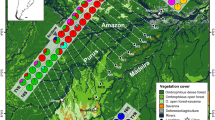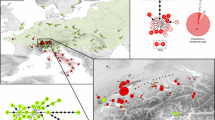Abstract
Natural hybridization between allopatric species following secondary contact has been poorly documented for Neotropical anurans inhabiting the Amazonian lowlands. We conducted a genetic survey across a contact zone between two species of litter frogs, Allobates hodli and Allobates femoralis (family Dendrobatidae), located on the left riverbank of the upper Madeira River, State of Rondônia, Brazil. We obtained tissue samples from 11 sampling sites on both riverbanks, covering approximately a 400 km long transect. We evaluated the genetic relationships between samples using haplotype networks and a distance-based phylogenetic tree obtained from a dataset of 16S rRNA mtDNA sequences. Estimates of genetic diversity, population structure, and the identification of sites where genetic admixture occurred were carried out by means of frequency-based methods and Bayesian inference on mtDNA and a set of four microsatellite loci, including samples collected throughout the study area. A reduced dataset including only microsatellite loci genotyped from samples on the left riverbank was applied in assignment tests for detecting levels of admixture at the contact zone and adjacent sampling sites, and for detecting and quantifying hybrid individuals. Our results suggest that genetic introgression between A. hodli and A. femoralis is restricted to the core area of the contact zone, where potential hybrids are less frequent than parental genotypes. Effects on the genetic variability of adjacent populations are only detected at sites located 1.5 km downstream and upstream of the core area, suggesting the existence of selection against hybrids, possibly mediated by postzygotic isolation mechanisms. The contact zone between A. femoralis and A. hodli is the first well delimited suture line between anuran species ever documented in the Brazilian Amazon. The settlement of two dams along the upper Madeira River poses an immediate threat to the gene flow and hybridization balance observed between the populations studied. Our results provided guidelines for a current monitoring program, aiming at the impacts of dams on this evolutionary system’s dynamics.








Similar content being viewed by others
References
Allendorf FW, Luikart G (2007) Conservation and the genetics of populations. Blackwell, Oxford
Amézquita A, Lima AP, Jehle R, Castellanos L, Ramos O, Crawford AJ, Gasser H, Hödl W (2009) Calls, colours, shapes, and genes: A multi-trait approach to the study of geographic variation in the Amazonian frog Allobates femoralis. Biol J Linn Soc 98:826–838
Anderson EC, Thompson EA (2002) A model-based method for identifying species hybrids using multilocus genetic data. Genetics 160:1217–1229
Arnold ML, Bulger MR, Burke JM, Hempel AL, Williams JH (1999) Natural hybridization: how low can you go and still be important? Ecology 80(2):371–381
Barton NH, Hewitt GM (1985) Analysis of hybrid zones. Ann Rev Ecol Syst 16:133–148
Boecklen WJ, Howard DJ (1997) Genetic analysis of hybrid zones: numbers of markers and power resolution. Ecology 78(8):2611–2616
Brown J, Twomey E (2009) Complicated histories: three new species of poison frogs of the genus Ameerega (Anura: Dendrobatidae) from north-central Peru. Zootaxa 2049:1–38
Burton RS, Ellison CK, Harrison JS (2006) The sorry state of F2 hybrids: Consequences of rapid mitochondrial DNA evolution in allopatric populations. Am Nat 168(Supplement):14–24
Clement M, Posada D, Crandall KA (2000) TCS: a computer program to estimate gene genealogies. Mol Ecol 9:1657–1659
Clemons KS (2007) Hydroeletric dams: transboundary environmental effects and international law. Fla State University Law Rev 36:487–536
Corander J, Tang J (2007) Bayesian analysis of population structure based on linked molecular information. Math Biosci 205:19–31
Corander J, Marttinen P, Sirén J, Tang J (2008) Enhanced Bayesian modelling in BAPS software for learning genetic structures of populations. BMC Bioinforma 9:539
Coyne JA, Orr HA (2004) Speciation. Sinauer, Sunderland
Darst CR, Cummings ME, Cannatella DC (2006) A mechanism for diversity in warning signals: Conspicuousness versus toxicity in poison frogs. PNAS 103(15):5852–5857
Dawe KL, Shafer ABA, Herman TB, Stewart DT (2009) Diffusion of nuclear and mitochondrial genes across a zone of secondary contact in the maritime shrew, Sorex maritimensis: implications for the conservation of a Canadian endemic mammal. Conserv Genet 10:851–857
DeWoody JA, Shupp J, Kenefic L, Busch J, Murfitt L, Keim P (2004) Universal method for producing ROX-labeled size standards suitable for automated genotyping. Biotechniques 37:348–352
DNPM—Departamento Nacional da Produção Mineral—Brasil (1978) Projeto RADAMBRASIL—Levantamento dos recursos naturais, Vol.18, Folha SC 20, Porto Velho: Geologia, geomorfologia, pedologia, vegetação e uso potencial da terra. Departamento Nacional da Produção Mineral, Rio de Janeiro
Doyle JJ, Doyle JL (1987) A rapid DNA isolation procedure for small quantities of fresh leaf tissue. Phytochem Bull 19:11–15
Erdtmann LK, Simões PI, Mello AC, Lima AP (2011) Do natural differences in acoustic signals really interfere in conspecific recognition in the pan-Amazonian frog Allobates femoralis? Behaviour 148:485–500
Genovart M (2009) Natural hybridization and conservation. Biodivers Conserv 18:1435–1439
Göd M, Franz A, Hödl W (2007) The influence of internote-interval variation of the advertisement call on the phonotactic behaviour in male Allobates femoralis (Dendrobatidae). Amphibia-Reptilia 28:227–234
Goudet J (2001) Fstat, a program to estimate and test gene diversities and fixation indices (version 2.9.3). Available from http://www.unil.ch/izea/softwares/fstat.html
Grant PR, Grant BR (1992) Hybridization of bird species. Science 256(5054):193–197
Grant PR, Grant BR (2002) Unpredictable evolution in a 30-year study of Darwin’s finches. Science 296:707–711
Grant T, Frost DR, Caldwell JP, Gagliardo R, Haddad CFB, Kok PJR, Means BD, Noonan BP, Schargel W, Wheeler WC (2006) Phylogenetic systematics of dart-poison frogs and their relatives (Anura: Athesphatanura: Dendrobatidae). Bull Am Mus Nat Hist 299:1–262
Haffer J (1997) Alternative models of vertebrate speciation in Amazonia: An overview. Biodivers Conserv 6:451–476
Haig SM, Mullins TD, Forsman ED, Trail PW, Wennerberg L (2004) Genetic identification of Spotted Owls, Barred Owls, and their hybrids: legal implication of hybrid identity. Conserv Biol 18:1347–1357
Hall TA (1999) BioEdit: a user-friendly biological sequence alignment editor and analysis program for Windows 95/98/NT. Nucleic Acids Symp Ser 41: 95–98
Hird S, Sullivan J (2009) Assessment of gene flow across a hybrid zone in red-tailed chipmunks (Tamias ruficaudus). Mol Ecol 18:3097–3109
Höbel G, Gerhardt HC (2003) Reproductive character displacement in the acoustic communication system of gree tree frogs (Hyla cinerea). Evolution 57(4):894–904
Hödl W, Amézquita A, Narins PM (2004) The rôle of call frequency and the auditory papillae in phonotacticbehavior in male dart-poison frogs Epipedobates femoralis (Dendrobatidae). J Comparative Physiol A 190:823–829
Hofman S, Szymura JM (2007) Limited mitochondrial DNA introgression in a Bombina hybrid zone. Biol J Linn Soc 91:295–306
Hoorn C, Wesselingh FP (2010) Amazonia, landscape and species evolution. Blackwell, Oxford
Hoskin CJ, Higgie H, McDonald KR, Moritz C (2005) Reinforcement drives rapid allopatric speciation. Nature 437:1353–1356
Jehle R, Gasser H, Amézquita A, Lima AP, Hödl W (2008) Ten polymorphic microsatellite loci for Allobates femoralis, an Amazonian dendrobatoid frog. Mol Ecol Resour 8(6):1326–1328
Jiggins CD, Mallet J (2000) Bimodal hybrid zones and speciation. Trends Ecol Evol 15(6):250–255
Keller B, Wolinska J, Manca M, Spaak P (2008) Spatial, environmental and anthropogenic effects on the taxon composition of hybridizing Daphnia. Philos Trans R Soc B 363:2943–2952
Laurance WF, Albernaz AKM, Fearnside PM, Vasconcelos HL, Ferreira LV (2004) Deforestation in Amazonia. Science 304:1109
Lemmon EM, Lemmon AR, Collins JT, Lee-Yaw JA, Cannatella DC (2007) Phylogeny-based delimitation of species boundaries and contact zones in the trilling chorus frogs (Pseudacris). Mol Phylogenet Evol 44:1068–1082
Levin DA, Francisco-Ortega J, Jansen RK (1996) Hybridization and the extinction of rare plant species. Conserv Biol 10(1):10–16
Librado P, Rozas J (2009) DnaSP v5: a software for comprehensive analysis of DNA polymorphism data. Bioinformatics 25:1451–1452
Moritz C, Patton JL, Schneider CJ, Smith TB (2000) Diversification of rainforest faunas: an integrated molecular approach. Annu Rev Ecol Syst 31:533–563
Moritz C, Hoskin CJ, MacKenzie JB, Phillips BL, Tonione M, Silva N, VanDerWal J, Williams LE, Graham CH (2009) Identification and dynamics of a cryptic suture zone in tropical rainforest. Proc R Soc B 276:1235–1244
Palumbi SR (1996) Nucleic acids II: the polymerase chain reaction. In: Hillis DM, Moritz C, Mable BK (eds) Molecular systematics. Sinauer, Sunderland, pp 205–247
Peakall R, Smouse PE (2006) GENALEX 6: genetic analysis in Excel. Population genetic software for teaching and research. Mol Ecol Notes 6:288–295
Perz S, Brilhante S, Brown F, Caldas M, Ikeda S, Mendoza E, Overdevest C, Reis V, Reyes JF, Rojas D, Schmink M, Souza C, Walker R (2008) Road building, land use and climate change: prospects for environmental governance in the Amazon. Philos Trans R Soc B 363:1889–1895
Pfennig KS (2003) A test of alternative hypothesis for the evolution of reproductive isolation between spadefoot toads: support for the reinforcement hypothesis. Evolution 57(12):2842–2851
Pritchard JK, Stephens M, Donnelly P (2000) Inference of population structure using multilocus genotype data. Genetics 155:945–959
Saitou N, Nei M (1987) The neighbor-joining method: a new method for reconstructing phylogenetic trees. Mol Biol Evol 4:406–425
Santos JC, Coloma LA, Summers K, Caldwell JP, Ree R, Cannatella DC (2009) Amazonian amphibian diversity is primarily derived from Late Miocene Andean lineages. PLoS Biol 7(3):1–14
Sanz N, Araguas RM, Fernández R, Vera M, García-Marín JL (2009) Efficiency of markers and methods for detecting hybrids and introgression in stocked populations. Conserv Genet 10:225–236
Seehausen O (2004) Hybridization and adaptive radiation. Trends Ecol Evol 19(4):198–206
Seehausen O, Takimoto G, Roy D, Jokela J (2007) Speciation reversal and biodiversity dynamics with hybridization in changing environments. Mol Ecol 17(1):30–44
Simões PI, Lima AP, Magnusson WE, Hödl W, Amézquita A (2008) Acoustic and morphological differentiation in the frog Allobates femoralis: relationships with the upper Madeira River and other potential geological barriers. Biotropica 40(5):607–614
Simões PI, Lima AP, Farias IP (2010) The description of a cryptic species related to the pan-Amazonian frog Allobates femoralis (Boulenger 1883) (Anura: Aromobatidae). Zootaxa 2406:1–28
Tamura K, Nei M (1993) Estimation of the number of nucleotide substitutions in the control region of mitochondrial DNA in humans and chimpanzees. Mol Biol Evol 10:512–526
Tamura K, Dudley J, Nei M, Kumar S (2007) MEGA4: Molecular Evolutionary Genetics Analysis (MEGA) software version 4.0. Mol Biol Evol 24:1596–1599
Templeton AR, Crandall KA, Sing CF (1992) A cladistic analysis of phenotypic associations with haplotypes inferred from restriction endonuclease mapping and DNA sequence data. III. Cladogram estimation. Genetics 132:619–633
Thompson JD, Higgins DG, Gibson TJ (1994) Improved sensitivity of profile searches through the use of sequence weights and gap excision. Comput Appl Biosci 10(1):19–29
Vogel LS, Johnson SG (2008) Estimation of hybridization and introgression frequency in toads (Genus: Bufo) using DNA sequence variation at mitochondrial and nuclear loci. J Herpetol 42(1):61–75
Vorndran IC, Reichwaldt E, Nürnberger B (2002) Does differential susceptibility to predation in tadpoles stabilize the Bombina hybrid zone? Ecology 83(6):1648–1659
Wells KD (2007) The ecology and behavior of amphibians. The University of Chicago Press, Chicago
Acknowledgments
We thank Walter Hödl, Daniel Rodrigues Santos, Pedro Rodrigues Santos, Adolfo Amézquita, and Iliana Medina for helping us during field work. We thank Mr. Bento Pereira da Silva for allowing us camping at his property for several occasions. We are grateful to Eva Ursprung and Robert Jehle for providing information on microsatellite primers and protocols. We thank Jeff Podos, José Manuel Padial, Marcelo Menin, Mario Cohn-Haft, Marina Anciães, José A. Alves Gomes, Tomas Hrbek, and Daniel Toffoli for suggestions and comments on earlier drafts of the manuscript. Conselho Nacional de Desenvolvimento Tecnológico (CNPq) provided funding for field excursions and laboratory analyses and equipment (CT-Amazônia/CT-Energia No. 13/2006; 470811/2006—Ed 02/2006 Universal; CNPq/CTAmazônia 575603/2008-9). Field work done between 2004 and 2005 received logistical support from Furnas Centrais Elétricas S.A. Collecting permits were provided by RAN-ICMBio/IBAMA (004/03-RAN; 131/04-RAN; 037/2007-RAN/; 13894-1/2009-RAN). Tissue collection permits were provided to CTGA-ICB/UFAM by deliberation nº 75 of August 26, 2004, by CGEN-IBAMA. P.I. Simões received a doctoral fellowship from CNPq from 2006-2010, while conducting this study.
Author information
Authors and Affiliations
Corresponding author
Electronic supplementary material
Below is the link to the electronic supplementary material.
Rights and permissions
About this article
Cite this article
Simões, P.I., Lima, A.P. & Farias, I.P. Restricted natural hybridization between two species of litter frogs on a threatened landscape in southwestern Brazilian Amazonia. Conserv Genet 13, 1145–1159 (2012). https://doi.org/10.1007/s10592-012-0362-x
Received:
Accepted:
Published:
Issue Date:
DOI: https://doi.org/10.1007/s10592-012-0362-x




